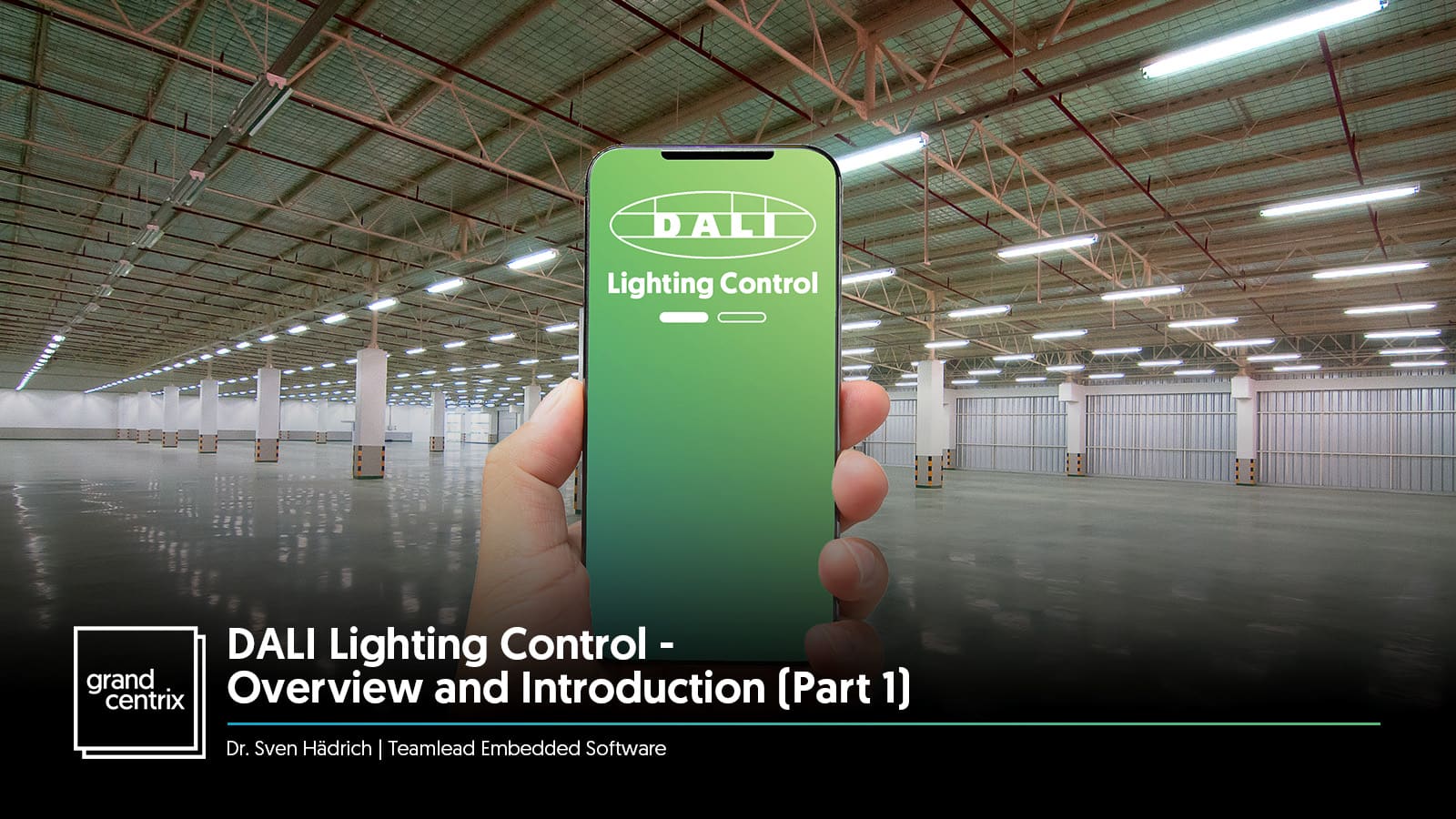
What is DALI?
DALI, standing for Digital Addressable Lighting Interface, is a widely recognised standard facilitating communication among all kinds of lighting components.
At the heart of the DALI standards is a simple yet effective physical interface. It simply requires two wires to connect the bus members. It supports bus and star topologies as well as mixtures of both. The ring topology should be avoided. This allows sharing a single cable for both line power supply and DALI communication. Thus, there is no additional overhead to provide the DALI signals to a lighting installation.
Electrically speaking, the DALI bus uses typically 16 Volts in idle mode and transitions to the active mode are indicated by pulling the voltage to ground level. The DALI connections are interchangeable, so there is no designated ground connector. It is allowed to use the DALI bus as a power source for DALI devices, thereby reducing the need for multiple power sources. The standard employs low data rates and Manchester coding, so almost any micro controller is capable of receiving and transmitting DALI frames. The protocol itself is anything but complex, so only few resources are needed to implement DALI. This ease of integration underscores DALI’s role as a user-oriented, adaptable interface standard in the lighting industry.

What is covered by the DALI Standard?
The DALI standard encompasses a range of devices integral to lighting systems, specifying interfaces for various light sources, notably including Light Emitting Diodes (LEDs). It also details interfaces for control elements like pushbuttons, occupancy detectors, and light level detectors.
Within the DALI framework, an entity known as the Application Controller plays a pivotal role in coordinating interactions between light sources and control elements. The Application Controller decides which control element triggers which reaction from the light sources. While the standard sets parameters for these interactions, it grants manufacturers considerable latitude in determining the specific capabilities of their Application Controllers.
The Integration of Application Controllers into devices such as pushbutton panels and occupancy sensors is common, although these controllers often possess only a limited feature sets. In contrast, some dedicated devices serve primarily as Application Controllers within the DALI network, often integrated into bridges that connect the DALI system to other communication standards, such as TCP/IP or KNX.
The standard categorizes devices into distinct sub-classes to address specific application needs, such as emergency and street lighting. This classification enables targeted functions like automated testing and reporting for emergency lighting systems. Furthermore, DALI facilitates the monitoring of energy usage and the status of each lighting unit, streamlining maintenance and operational efficiency without incurring additional costs.
Is the protocol accessible?
The DALI Alliance is the driving force behind that standard. It is an industry alliance with partners from different fields of the lighting industry. The wide adoption of the DALI standards is goal of the DALI Alliance. Hence, DALI is openly published as an IEC standard. Anyone who wants to work with DALI devices can buy these standards and dive into the world of DALI. To get an idea how the different components of DALI systems interact it is nice to visualize the messages that are transferred via the bus. To do so, one can use an DALI to USB adapter and a piece of software that translates the bits and bytes into human readable messages.
Acronym Overload - DALI, DALI-2, D4i, Zhaga, eDALI, DALI+
The DALI standard looks back on a long history. The road to the current form of the DALI standard is paved with branches from the initial standard and extensions. For instance, there is the original DALI standard, as it was published in 2009. The original standard was restricted to light sources and only a loose self-testing was necessary. Today, we have the DALI-2 standard, that requires all devices to pass rigorous testing and verification of their conformity. D4i uses the foundations of the DALI-2 certification and describes some specific embodiment that is useful for smart integrated (LED driver, control device) luminaries. Beyond D4i is the Zhaga standard which defines changeability beyond the light control method and defines physical and electrical dimensions of all kind. Before newer DALI standards covered all aspects of a lighting systems, some areas were unregulated and manufacturers patched their own specific implementations into the DALI bus. The robust nature of the DALI bus allowed this, and these patches like the eDALI standard are sometimes still around. Though, whenever possible one should stick to the officially standardized DALI-2 solution. Recently released is DALI+ certification for DALI devices over wireless and IP-based networks. All are based on the DALI protocol for communication between lighting-control devices.
How can I certify my DALI device?
The DALI Association recognizes the importance of interoperability across lighting systems, understanding that not every LED driver manufacturer aims to produce control devices, and vice versa. Achieving uniformity through adherence to a shared standard benefits both manufacturers and customers, facilitating the integration of components from various producers into cohesive lighting solutions. The establishment of the DALI Association primarily serves to endorse a certification mark, indicating that products meet established criteria for compatibility and interoperability. The association adopts a transparent approach regarding membership fees and the costs associated with necessary testing equipment, ensuring these are accessible and reasonable. A central tool in this context is the DALI-Tester. It is a measuring device specifically built for this purpose, that can automatically execute the test sequences that are provided by the DALI Association to all its members. The test protocols form this test setup are sufficient to get a listed certification for a device. This enables manufacturers to opt either for an external test laboratory, or to invest into a DALI Tester and run the tests themselves. It is noteworthy that completing the test suite for a single LED driver or control device typically encompasses nearly an entire workday, albeit many tests proceed without the need for constant supervision.

What are known disadvantages of DALI?
The low data rate of DALI is advantageous for its resistance to noise interference, minimal cable requirements, and the simplicity of designing physical interfaces. However, this characteristic restricts rapid data transmission, leading to a sluggish experience for more complex operations. The initial bus discovery and enumeration can take tenth of minutes. Something one is not used from modern, high speed interfaces. Decisions regarding the DALI standard’s technical aspects are determined by committees, which can make it challenging to trace the exact reasoning behind specific choices within the standard. While these decisions are not inherently positive or negative, greater transparency regarding their basis could enhance understanding of the standard’s structure and implementation.
